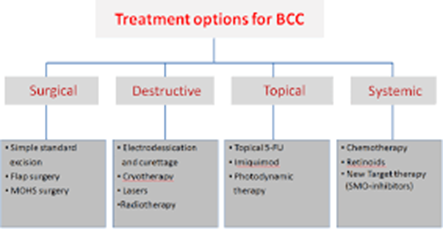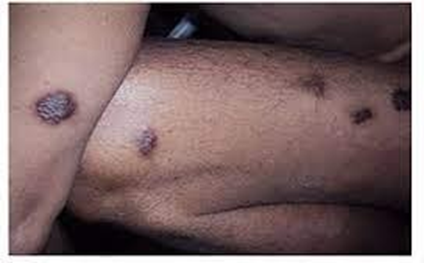A nurse is caring for a client who has questions concerning the various treatment options for his new diagnosis of basal cell carcinoma. Which of the following treatments should the nurse include in the discussion? (Select all that apply)
Radiation therapy
Topical corticosteroids
Micrographic surgery
Electrosurgery
Correct Answer : A,C,D
Choice A rationale: radiation therapy is one of the possible management options for basal cell carcinoma (BCC) that uses high-energy rays to kill the cancerous cells.
Choice B rationale: this is incorrect since topical corticosteroids are ineffective in BCC management and may worsen the patient’s condition by suppressing their immune system.
Choice C rationale: micrographic surgery can be used in BCC management and it involves the removal of thin layers of skin to a point where no cancer cells can be detected.
Choice D rationale: this is appropriate and involves the use of electric current to burn off the cancer cells.

Nursing Test Bank
Naxlex Comprehensive Predictor Exams
Related Questions
Correct Answer is C
Explanation
Choice A rationale: Actinic keratosis presents as rough, scaly patches on sun-exposed skin and is not associated with the purplish-brown lesions seen in Kaposi's sarcoma.
Choice B rationale: Basal cell carcinoma typically presents as pearly or waxy bumps and is not characterized by widespread purplish-brown lesions.
Choice C rationale: Kaposi's sarcoma is characterized by the development of purplish-brown skin lesions, and it is commonly associated with advanced HIV/AIDS.
Choice D rationale: Toxic epidermal necrolysis is a severe skin reaction but is not typically associated with purplish-brown lesions.

Correct Answer is D
Explanation
Adding these percentages together:
- Anterior trunk: 18%
- Perineum: 1%
- Left anterior arm: 4.5%
- Left posterior arm: 4.5%
Total = 18% + 1% + 4.5% + 4.5% = 28%
Whether you are a student looking to ace your exams or a practicing nurse seeking to enhance your expertise , our nursing education contents will empower you with the confidence and competence to make a difference in the lives of patients and become a respected leader in the healthcare field.
Visit Naxlex, invest in your future and unlock endless possibilities with our unparalleled nursing education contents today
Report Wrong Answer on the Current Question
Do you disagree with the answer? If yes, what is your expected answer? Explain.
Kindly be descriptive with the issue you are facing.
